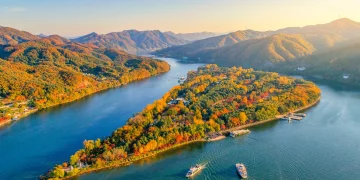First Impressions of Kolkata
On the occasion of commemorating the 100th anniversary of Rabindranath Tagore’s visit to China, during the early autumn when summer flowers had withered and autumn leaves had yet to fall, I was invited by the Chinese Institute of Visva – Bharati University in India. As a translator of Tagore’s poetry, along with several domestic university scholars researching Tagore, we traveled thousands of miles and after many twists and turns, arrived in Kolkata, Tagore’s hometown, during the grand annual festival of Durga Puja.
When our group arrived at the Kolkata airport, it was already early morning local time. But as we walked out of the airport, it was still brightly lit and crowded. Driving through the streets of Kolkata at midnight, the new and old parts of the city made it seem like we were traveling through different eras. The traffic was congested but not chaotic, and surprisingly, there were no “sacred cows” roaming the streets. For me, setting foot on this land for the first time, it was all rather novel and unexpected.
The hotel I stayed in was in the city center of Kolkata, next to a small commodity market that somewhat resembled the domestic scene in the 1980s and 1990s in China. The polite bellboys and front – desk staff, and the lobby that was not overly luxurious but had a certain charm, were not much different from domestic star – rated hotels. What was different was that there were security inspection equipment at the hotel entrance, and a statue of the goddess Durga placed in the middle of the hotel exuded a strong festive atmosphere.
Ancient and modern coexisted, and poverty and wealth were side by side. The wealthy in single – family high – rises lived next to the poor huddled under eaves. Among the various old and new, high and low buildings, the ancient Victorian – era architectures emerged and disappeared. The once – luxurious decorations were now mottled, just like the name of our hotel “Peerless”, still showing glimpses of its former glory.

Before the fatigue of the long journey had dissipated, I walked onto the festival streets of Kolkata. Durga pandals and decorations could be seen everywhere, and the magnificent and tall temples were crowded with people. On closer inspection, the beautiful “buildings” of the temples were actually made of foam materials and would be dismantled and discarded after the festival. The streets in the old city of Kolkata were crowded with people and vehicles. Japanese Suzuki cars were the most common. Buses and taxis seemed to have fallen behind the times. Cars passed through narrow alleys, squeezing between pedestrians and vehicles, yet somehow managed to get through the congestion.
For Chinese stomachs accustomed to rich cuisine, the food in Kolkata’s hotels and restaurants was rather unappealing. There was not much meat – no beef or pork, mainly chicken, and occasionally fish. There were also few vegetables – mainly potatoes, along with some cucumbers and tomatoes. There was a wide variety of naan and flatbreads, and lentil soup and milk tea were considered common delicacies.
Tagore’s former residence museum was located in the old city. Unfortunately, it was closed during Durga Puja, so I only took a few photos at the entrance. In 1861, Tagore was born into a noble family in Kolkata, India. The Tagore family belonged to the Brahmin caste, the highest in India. Tagore’s ancestors were wealthy merchants, and he received an excellent education from a young age. In 1913, he became the first Asian to win the Nobel Prize in Literature with “Gitanjali”. In 1941, Tagore passed away at the age of 80. He wrote more than 50 poetry collections, 15 medium – and long – novels, 94 short stories, more than 60 plays, over 2,000 songs, and over 2,000 paintings in his life. His poetry was once very popular in China and influenced a group of advanced literati. In 1924, he made his first visit to China, accompanied by Lin Huiyin and Xu Zhimo, and the three formed a deep friendship.
A Poetic Journey on the Train
In 1921, Tagore founded Visva – Bharati University 180 kilometers north of Kolkata in Shantiniketan (formerly translated as “Santiniketan”). In 1937, the Chinese Institute was established. The destination of our group was the Chinese Institute of Visva – Bharati University in Shantiniketan, and we needed to take a train from Kolkata to get there.
Howrah Railway Station near Kolkata was bustling. Cars could drive right up to the platform. There was no security check or ticket inspection, and we could board the train directly. We took an air – conditioned carriage, which was in slightly better condition. The journey was about three hours, and the ticket price was about 50 yuan in Chinese currency. There were power sockets and reading lights in the air – conditioned carriage, with five seats in each row. The carriage was not crowded, and everyone sat in their seats. Occasionally, milk – tea vendors and wandering singers from West Bengal passed by.
Both ends of the train carriage bound for the “silent poetic land” were filled with Tagore elements. The wise and solemn gaze of Tagore in the portraits seemed to fall on my heart, and I couldn’t help but recite the classic lines of poetry beside the portraits – “We come nearest to the great when we are great in humility.” “Our nature is hidden from us by the work of our desires or our fears. The mother reveals herself in the service of the child. So our true freedom is not the freedom to act but the freedom in action, which can only be achieved in the work of love.”
When we arrived in Shantiniketan, the lights were already on. Tagore’s portraits were everywhere in the Shantiniketan station, as if the great poet had always been alive beside people.
The campus of the Chinese Institute was not large. There were low courtyard walls, tall banyan trees, and a two – story small building standing in the middle. There was a not – very – spacious lecture hall, rather simple classrooms, plain offices, and a library. “Though small, it has all the necessary parts.” In 1957, Premier Zhou Enlai visited the Chinese Institute and donated a large number of books, which are still treasured in the library of the Chinese Institute to this day. During this conference, I was lucky enough to see the books inscribed by Premier Zhou himself.
The International Seminar on Tagore’s Educational Thought was held in the lecture hall of the Chinese Institute. The lecture hall was packed with students sitting on the floor. Four scholars from domestic universities and Indian experts had in – depth exchanges around Tagore’s educational thought and its practical significance. I gave an English speech titled “Teaching through Poetry: Symbols of Vitality in Tagore’s English Poetry” at the meeting, comparing Tagore’s English poems rich in symbols of vitality such as fireflies and grass with relevant Chinese classical poems, and recited relevant poems of Mr. Tagore, which elicited a strong response from the Indian teachers and students present. Unexpectedly, instead of applauding, the audience cheered and shouted in Bengali from time to time.





















